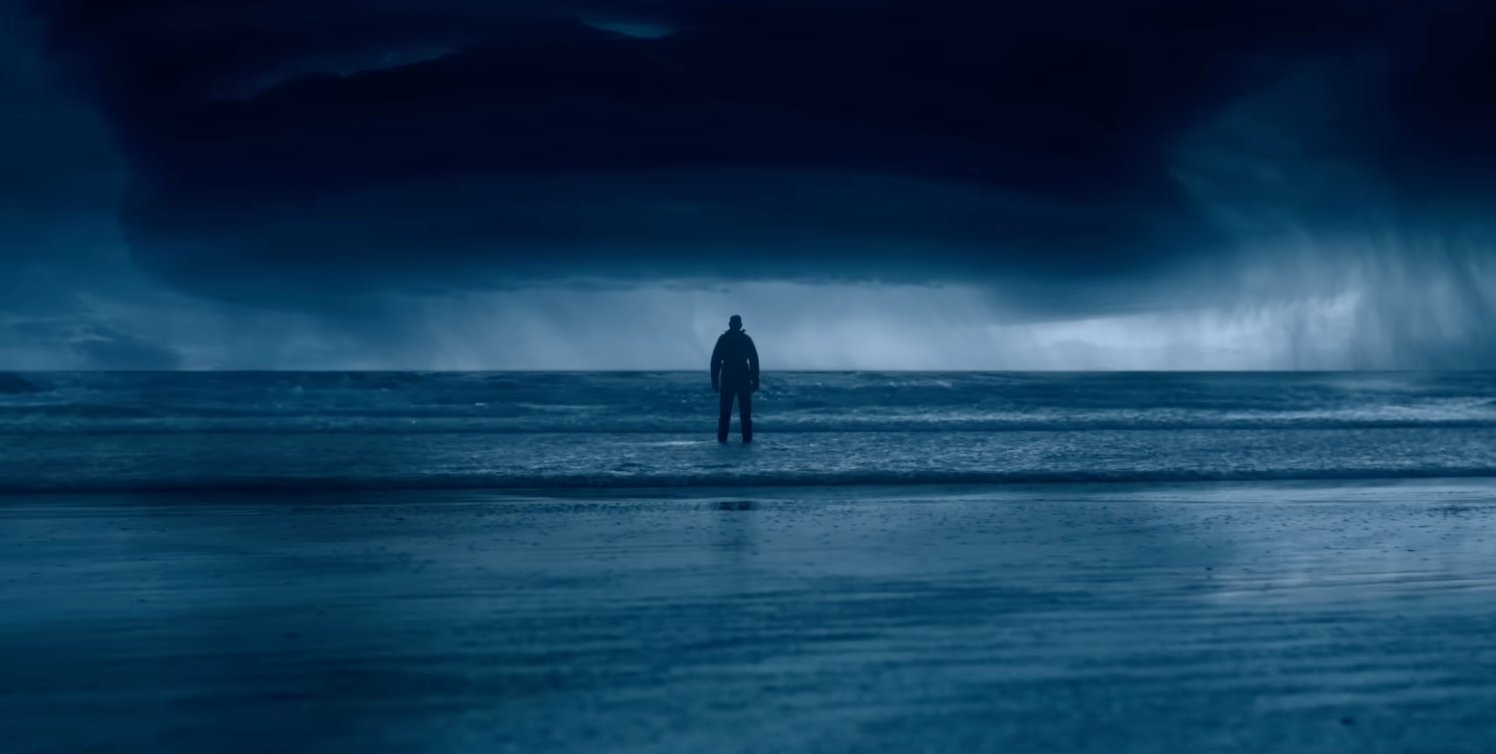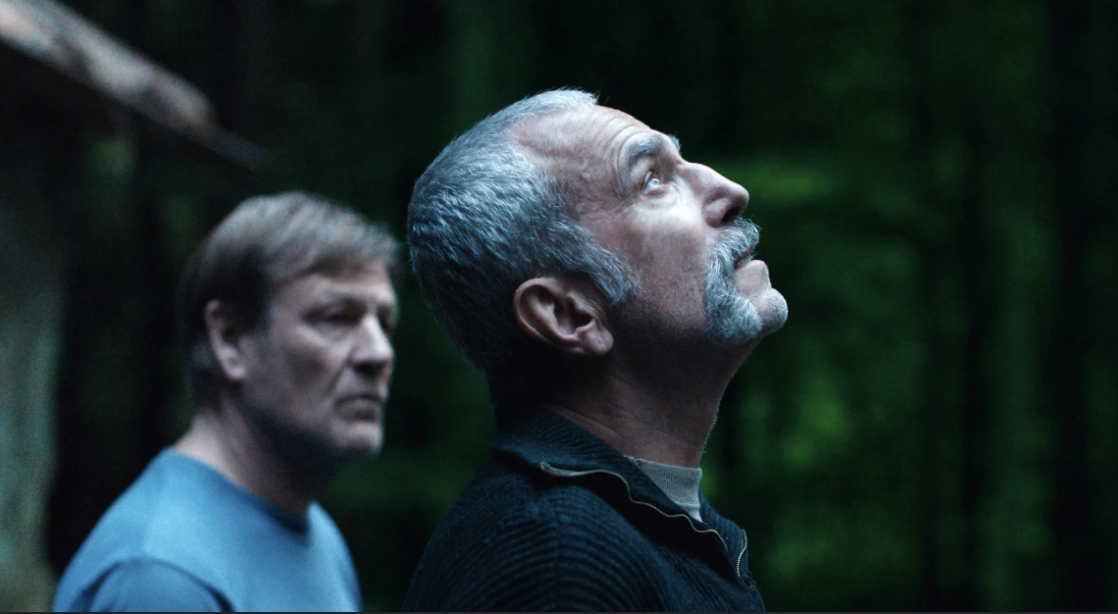In her essay on Ronan Day-Lewis’s Anemone, Polina Cosgrave unpacks a film that drifts between memory, myth and the metaphysical.
Whereas behind, our fate crept in resembling
a madman with a razor in his fist.
-Arseni Tarkovsky
FOLLOW THE WIND
Anemone, a delicate wildflower. The word stems from anemos – ‘wind’ in Greek. Aphrodite’s dead lover’s blood turned into fragile plants. Windflowers. Lilies of the field mentioned in the Bible. They toil not, neither do they spin. Especially when looked after by Ray Stoker (portrayed by Daniel Day-Lewis), an ex-member of the 14 Intelligence Company, an alleged war criminal, an uncompromising recluse, who plants these white flowers just like his father did.
The first phenomenon we notice in Anemone is wind. A gush of wind through the field. Then a vast plentiful forest, from a bird’s view. We follow that wind while it is passing through fractals of tree crowns. It is the breath of the film, and we will be constantly reminded of its presence or absence, this wind will reveal, connect, prophesy; it is almost as central a character in Anemone as Ray Stoker. In accordance with this symbolism, the movements of the camera are wind-like – the frame is almost never still in the opening sequence, we are carried by it like petals. The weather forecast comes in intensifying this tendency: six to gale eight, severe gale nine later. The rustling trees, the animalistic howling, the shifting clouds, and of course the main character’s visceral reaction to it, when he lifts his head up while eating to acknowledge the wind, or to question god, as Ray’s premonition of coming change grows. It is rare to capture such a profound relationship with the wind, and I doubt it has been done this effortlessly since the opening minutes of Tarkovsky's Mirror.
The first words we hear in the film are Jem’s (Sean Bean) prayer. His abode, in sharp contrast to Ray’s, has a special place for god. Nessa (Samantha Morton) has been praying for Ray for two decades, while her son Brian (Samuel Bottomley), more like his biological father, who really gets the kick out of sacrilege, rejects this religiousness by asking his mother: ‘Why does everything have to be blessed?’ Ray, like his son, and unlike the other characters, doesn’t address god. He also quite enjoys blasphemy. But it is to him and Brian that the hidden world of surreal entities and ideas reveals its presence. It’s in Ray’s pupils we see the reflection of the purifying fire or the bright blue flicker. It is for him mainly that the wind is singing its song. Which leads us into the realm of spiritual depth and meditations on moral position.
What Ronan Day-Lewis has created is not exactly cinema, it seems to be a different art form. It is still an exploration of a human face, its dramatic structure still takes us on a remarkable journey as it should, without following too many rules. But this is more than just an immersive experience, it is a two-hour-long poem camouflaged as a film. Anemone is a spiritual and intellectual detox in our digital era: think about the two-minute-long shot before the two brothers meet, preceded by Black Sabbath’s announcing ‘my future is shrouded in dark wilderness’. We are introduced to the hut Ray lives in, all its glorious asceticism and scarcity of means: the cellar door opens signifying he is always ready to escape, the axe in his hand set to strike with no hesitation, and when we hear the clicking noise we see Ray’s recognition – his brother Jem arrived, and now Ray can let go of the weapon (coincidentally, the clicking sound is associated with sea anemones – and it is used for communication by clownfish that live in symbiosis with them).
Ray breaks the twenty-year silence with two words: our inheritance, pointing at the device which was used by British soldiers so they could identify each other at distance, the device that announced Jem’s arrival. The sequence immediately sends us into the territory of symbols and codes dominating the film – almost like a Nabokov novel – we can read the plot, but we also have an opportunity to dive deep into the complex language of the film. Inheritance becomes the main theme – all its gear is aimed at breaking a generational curse. ‘Didn't have much luck with fathers, did we?' says Ray to his brother, after sharing a story about a priest who raped him in a care home. Mentioning their own father, after whom he adopted the practice of planting anemones, Ray reminds Jem of the constant physical abuse they were subjected to, although the latter admits that their father actually prayed for Ray until the day he died. Their elder’s inability to speak to his family mirrors Ray’s reticence.
The reunion of the brothers is followed by the juxtaposition of two shots – rain falling down on the roof from the fisheye perspective, and the boiling stew in macro. If Ray’s dwelling reminds us of the intense visual effects used by Caravaggio (like tenebrism), his abandoned partner’s house sustains a subdued and sombre palette of Picasso’s Blue Period. In these two opposing worlds, each object and colour is a continuation of the character and a judgement on their psychological state. Entering this film’s microcosm is like witnessing live paintings. You walk into Anemone like it’s a gallery.

THE SURREAL REALM AND FILM LEGACY
In several spectacular scenes we enter a transcendent space via Ray’s point of view. In his insomnia, he sees Nessa hovering over his bed, just like in the old photo of hers we encounter later in the story. Her hair is swept away by wind, which of course ‘rhymes’ with Margarita Terekhova frozen in time in Mirror, up in the air with her ex-husband, they share this space only in our imagination, but it doesn’t make the bond weaker. Same with Nessa and Ray – although in their case we don’t hear the woman saying ‘I love you’, we know she still does. Cut to Nessa in the current times, her image accompanied by the landmark soundtrack, there and then you know that these are shadows of love, and what a precise way to tell us that. It’s like a punch to the stomach – we feel their connection on a visceral level, we understand that those twenty years changed nothing, the thread connecting Ray and Nessa is as strong as ever. And the wind is gently playing with her hair, binding them together through the distance, the wind howl is also heard in the haunting music of the soundtrack while Nessa’s letter is voiced: 'silence burns after all these years, and I wonder if you still think about me, us…'
The physical portrayal of brotherhood is a masterclass on externalising the internal without a word. From the moment the two characters are in the room together their closeness reveals itself on a domestic level, the way their bodies relate to each other without a touch or a word. The dance scene, its delirious beauty, deserves a special mention: the use of time lapse and slow motion is unparalleled, it transports us into the centre of their interaction. Then the side of the house opens, creating an affinity (perhaps, accidental) to the iconic scene in Ryan Coogler’s Sinners. The light pulses like a heart, and our vision fades into the woods moving further and further from the two brothers, into silence and darkness. They are the fire in the dark wilderness; outside even the wind has died down.
Another recent allusion is set in the swimming scene, in which the brothers touch each other, their intimacy is unveiled. This sends us to the swimming lesson in Moonlight: the camera movement is that of a documentary style, it creates immediacy, we are witnessing the action from an eye-level perspective, like we are indeed submerged into the unsteady medium of the ocean. The waterline cuts the frame in half. The emotional distance between the characters shrinks.
When Ray shoots an animal in the woods (and most likely misses) we hear a scream that is similar to a human one. This is a tiny, but critical detail that will later expand our perception of Ray’s narration: ‘The only sound were the screaming’. Same function is carried by the milk and blood visual sequence, intestine shapes hanging from a tree: the audience gets to sense the destruction before hearing a tale about it. The imagery is complemented with Moonlight sonata, its sound muffled, we see a tiny explosion mark in the distance, and thunder comes into picture; the strong wind is back again. These elements supersede Ray’s confession, to prepare us for the bigger picture on a subconscious level. And when we get to the central moment of the film, the unrepenting monologue ingeniously performed by Daniel Day-Lewis, we are already familiar with the pain and confusion of his tragedy, its inexpressibility. Thus, our reaction to the horror Ray Stoker had lived through is intensified.
Another dreamlike moment is Ray meeting his son’s drawing in the perfect moonlight after his confession. Perhaps, finally confessing to his taking a life of a young boy has allowed him to face his fatherhood. The scene transforms the internet trend of turning kids’ doodles into lifelike images into an uncanny and dazzling art experience. Ray now is capable of encountering his son’s image within himself, his beating heart, his boyhood, and acknowledging Brian’s existence, his realness. Remember: the film ends with Ray actually meeting Brian and calling his name into his face when approaching, the magical feature of it is that the scene is mute and we only can read Ray’s lips, preceded by wind gently touching Nessa’s hair when she sees Ray for the first time in twenty years, as if he would finally touch her.
When the storm is brewing, it is brewing around Ray – and he becomes the eye of it. Brian feels this force in his room miles away when the hail hits the window. He takes a hailstone in his hand and examines it: the event unites their souls and existences. The hail is also hitting the flowers, the anemones, wiping the slate clean, signifying that Ray won’t pass the ‘legacy’ onto Brian, it stops with him. God or the higher powers are clearing space for a new life, a blank page. It is quite a Magnolia moment, i.e. the raining frogs. In some way Ronan Day-Lewis’ insistence on using those visual fundamentals is also related to the theme of inheritance. The hail scene not only establishes the connection between the generations, it is a moment of clarity and freedom, a moment where fate/creator/higher powers are manifesting their presence. It sends an impulse to stop and reflect, it’s akin to god touching the character’s shoulder – and only when Ray runs into his house to escape the hail we see the final realisation on his face. After the storm the wind is soft and gentle, and Ray’s anemones have been badly bruised, but not destroyed – like the legacy that has so much pain still can contain love and glory. We must accept both to move on beyond its ambivalence into the unknown future. Ray encounters an enormous fantastic fish floating down the stream, dead, killed by the hail. Maybe it’s a suggestion that only living fish are capable of swimming against the stream. Or maybe it is the salmon of knowledge – the old wisdom that is no longer relevant in the new circumstances.

EXQUISITE AGONY OF SELF-DENIAL
‘Non-alibi’ in being is a principle introduced by Mikhail Bakhtin, a major literary theorist and a philosopher of language. It is the moral and ethical principle of absolute and irrevocable personal responsibility.
Brian, as devoted and stubborn as his father, is still looking for the answer to the main question of his life: why did his father leave him and Nessa? His mother’s version doesn’t soothe him: the fact that Ray’s name was taken away along with his pride, the shame he potentially had to face, doesn’t redeem him in Brian’s eyes. However, the very reason he is in trouble is protecting his father’s name, thus, his legacy as a soldier. It is so important for Brian that he almost kills another boy, mirroring his father in more than one way. Jem reveals to Ray: ‘Brian is in the dark. Believer or nonbeliever, there are forces at work.’ Brian considers his father a coward, and states to his mother: ‘you gave me life, he gave me a fucking curse’. That curse is his inheritance, and Ray’s character has to undergo a deep transformation in order to break it – although it is not only him who is accountable for the darkness that fell upon him and his family: ‘War crime? The war were a fucking crime. And we were the phantom soldiers,’ – Ray announces to Jem. But it is still him who carries the duty to restore the balance.
In Ray’s value system, he has to run to not betray his spirit. The god they’ve had a war over is defied by Ray’s sense of responsibility – ‘I don’t need your fucking absolution’. He doesn’t need forgiveness. His jail is made of a different matter. No alibi – Ray killed a young boy, and even if it were a mercy killing, he is paying the price, his mind and body know – he is a murderer, so he forgoes a self-inflicted punishment to save his soul (and unlike Raskolnikov’s, his punishment actually leads to a crucial transmutation and a life-changing epiphany). We cannot delegate our moral responsibility, it is not that Ray Stoker’s position is more important than his family’s happiness, it is that the impeccable technical correctness of his act does not yet decide the question of its moral value. Could he be a saint in his own way, thus, he gets those special visions? What if the central relationship of the film is Ray’s relationship with god? Maybe he is a symbol of an artist – he is truly creative with the main tragedy of his life, he moulds his spirit as a sculptor, and through his eyes we see the world in a unique way. That would be a truly Tarkovsky idea: the artist is not talking to the audience, his work is in his dialogue with creator, whatever it might be. Invisible Man Ray Stoker stays unseen to himself up until he agrees to meet his maker, feels the omniscient presence, lets it in. Then he can see Brian, the fruit of his loins. Yet again, the wind is evoked visually and in sound to accompany Ray’s confession: moving sands of the beach, swishing in the dry grass.
Could Ray’s first confession to his brother be false – a preparation for the real one? He asks Jem if he really believes in his yarn about the defecation on the head of the rapist priest of their youth. But there is no such ambivalence for his second one: if he could or couldn't have saved the kid, if he pitied or hated him, it doesn’t matter. Ray did the crime and he was serving the time. Personal responsibility over everything else: ‘as for man, his days are like grass; he flourishes like a flower of the field; for the wind passes over it, and it is gone, and its place knows it no more.’ He accepted his fate, his inheritance, and now when it is verbalised – he can leave this weight behind, along with the anemones he was growing.
VOCABULARY
‘…over the years I began to understand filmmaking as a syntax, a vocabulary, a language.’ Sydney Pollack
As a viewer, I encountered Anemone as a beautiful gift from a stranger that was left on my doorstep. I unwrapped it, and it spoke to me so I could finally find myself, face myself, redeem myself. Because of the powerful ways in which this story is told, it gets inside you through your retina and changes you on a visceral level, like all true art does. If poetry, according to Joseph Brodsky, is the highest form of language, then this specimen is the highest form of cinema language.
The visual fundamentals of the film are borrowed from classics and modern masterpieces and perfected, just like the authors of Roman antiquity had influence on Joseph Brodsky’s style, as well as more contemporary English metaphysical poets. What I am arguing is that Ronan Day-Lewis has created his own thing – one that defies genre. We are witnessing his inventing of a new language. Day-Lewis’ vision is an event of a deeply individualistic nature, and I have no doubt that in a few years’ time there will be a whole case of Ronan Day-Lewis’ type of film, similar to Cronenberg’s films or PTA’s films.
Son and father here are operating on a brand new level. It’s multidimensional cinema, Ronan is certainly multilingual when it comes to this medium. He is the demiurge of the visual reality of this film and while utilising the phrases, codes, elements of his predecessors, not only he strengthens them with a laconic, yet mind-blowing soundtrack, he is continuously proving his own theorem, reorganizing the time dimension to portray life’s essence, stripping it down to the very core. Just like Andrei Tarkovsky uses his prolific father Arseni’s poetry and voice in Mirror, Ronan employs Daniel Day-Lewis’ performance in Anemone, which is an act of pure poetry – a distilled state of being human. While he is making tea or pouring whiskey, the intensity of his screen presence is so electric, so concentrated, it feels like there is a multiverse we can enter in just one of Daniel Day-Lewis’ lines or moves. Somehow this hologram of a man is better than himself each time we blink. Such alchemy between the two outstanding creators is a miracle to witness.

